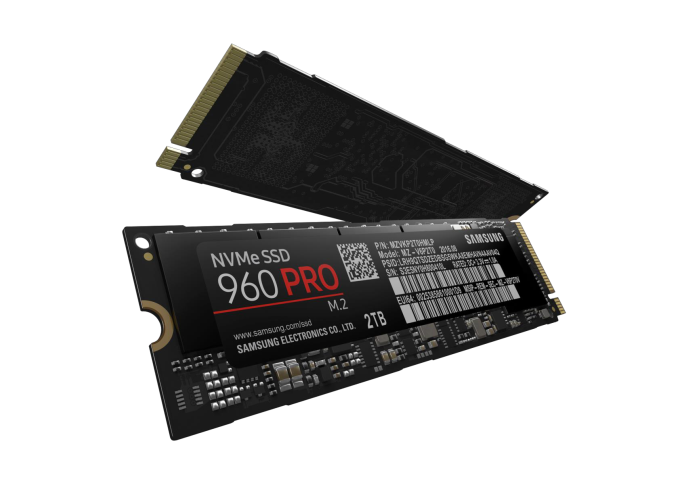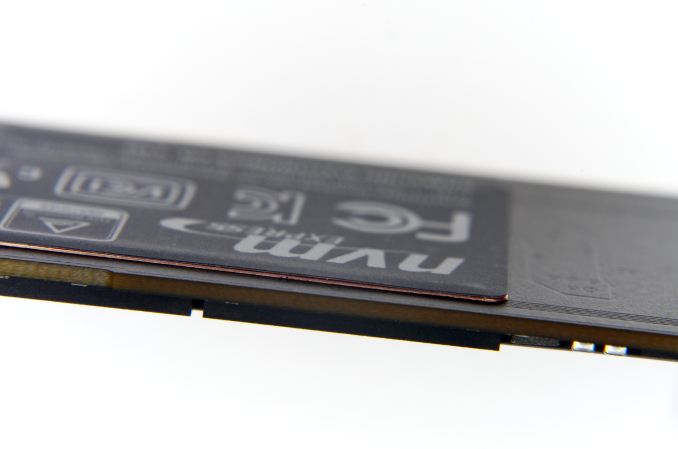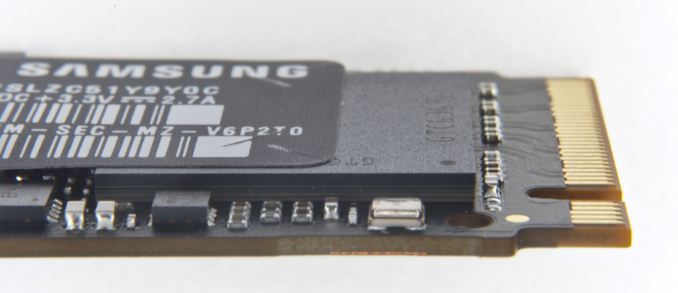The Samsung 960 Pro (2TB) SSD Review
by Billy Tallis on October 18, 2016 10:00 AM EST
A year ago, Samsung brought their PCIe SSD technology to the retail market in the form of the Samsung 950 Pro, an NVMe M.2 SSD with Samsung's 3D V-NAND flash memory. The 950 Pro didn't appear out of nowhere—Samsung had shipped two generations of M.2 PCIe SSDs to OEMs, but before the 950 Pro they hadn't targeted consumers directly.
Now, the successor to the 950 Pro is about to hit the market. The Samsung 960 Pro is from one perspective just a generational refresh of the 950 Pro: the 32-layer V-NAND is replaced with 48-layer V-NAND that has twice the capacity per die, and the UBX SSD controller is replaced by its Polaris successor that debuted earlier this year in the SM961 and PM961 OEM SSDs. However...
| Samsung 960 PRO Specifications Comparison | ||||||
| 960 PRO 2TB | 960 PRO 1TB | 960 PRO 512GB | 950 PRO 512GB |
950 PRO 256GB |
||
| Form Factor | Single-sided M.2 2280 | Single-sided M.2 2280 | ||||
| Controller | Samsung Polaris | Samsung UBX | ||||
| Interface | PCIe 3.0 x4 | PCIe 3.0 x4 | ||||
| NAND | Samsung 48-layer 256Gb MLC V-NAND | Samsung 32-layer 128Gbit MLC V-NAND | ||||
| Sequential Read | 3500 MB/s | 3500 MB/s | 3500 MB/s | 2500MB/s | 2200MB/s | |
| Sequential Write | 2100 MB/s | 2100 MB/s | 2100 MB/s | 1500MB/s | 900MB/s | |
| 4kB Random Read (QD1) | 14k IOPS | 12k IOPS | 11k IOPS | |||
| 4kB Random Write (QD1) | 50k IOPS | 43k IOPS | 43k IOPS | |||
| 4kB Random Read (QD32) | 440k IOPS | 440k IOPS | 330k IOPS | 300k IOPS | 270k IOPS | |
| 4kB Random Write (QD32) | 360k IOPS | 360k IOPS | 330k IOPS | 110k IOPS | 85k IOPS | |
| Read Power | 5.8W | 5.3W | 5.1W | 5.7W (average) | 5.1W (average) | |
| Write Power | 5.0W | 5.2W | 4.7W | |||
| Endurance | 1200TB | 800TB | 400TB | 400TB | 200TB | |
| Warranty | 5 Year | 5 Year | ||||
| Launch MSRP | $1299 | $629 | $329 | $350 | $200 | |
... looking at the performance specifications of the 960 Pro, it clearly is much more than just a refresh. Part of this is due to the fact that PCIe SSDs simply have more room to advance than SATA SSDs, so it's possible for Samsung to add 1GB/s to the sequential read speed and to triple the random write speed. But to bring about those improvements and stay at the top of a market segment that is seeing new competition every month, Samsung has had to make significant changes to almost every aspect of the hardware.
We've already analyzed Samsung's 48-layer V-NAND in reviewing the 4TB 850 EVO it first premiered in. The Samsung 960 Pro uses the 256Gb MLC variant, which allows for a single 16-die package to contain 512GB of NAND, twice what was possible for the 950 Pro. Samsung has managed another doubling of drive capacity by squeezing four NAND packages on to a single side of the M.2 2280 card. Doing this while keeping to that single-sided design required freeing up the space taken by the DRAM, which is now stacked on top of the controller in a package-on-package configuration.
Samsung's Polaris controller is also a major change from the UBX controller used in the 950 Pro. Meeting the much higher performance targets of the 960 Pro with the UBX controller architecture would have required significantly higher clock speeds that the drive's power budget wouldn't allow for. Instead, the Polaris controller widens from three ARM cores to five, and now dedicates one core for communication with the host system.
The small size of the M.2 form factor combined with the higher power required to perform at the level expected of a PCIe 3.0 x4 SSD means that heat is a serious concern for M.2 PCIe SSDs. In general, these SSDs can be forced to throttle themselves rather than overheat when subjected by intensive benchmarks and stress tests, but at the same time most drives avoid thermal throttling during typical real-world use. Most heavy workloads are bursty, especially at 2GB/sec.
Even so, many users would prefer the benefits of reliable sustained performance offered by a well-cooled PCIe SSD, and almost every M.2 PCIe SSD is now doing something to address thermal concerns. Toshiba's OCZ RD400 is available with an optional PCIe x4 to M.2 add-in card that puts a thermal pad directly behind the SSD controller. Silicon Motion's SM2260 controller integrates a thin copper heatspreader on the top of the controller package. Plextor's M8Pe is available with a whole-drive heatspreader. Samsung has decided to put a few layers of copper into the label stuck on the back side of the 960 Pro. This is thin enough to not have any impact on the drive's mechanical compatibility with systems that require a single-sided drive, but the heatspreader-label does make a significant improvement in the thermal behavior of the 960 Pro, according to Samsung.
 (click for full resolution close-up)
(click for full resolution close-up)
The warranty on the 960 Pro is five years, the same as for the 950 Pro but half of what is offered with the 850 Pro. When the 950 Pro was introduced, Samsung explained that the decreased warranty period on a higher-end product was due to NVMe and PCIe SSDs being a less mature technology than SATA SSDs. Despite having a very successful year with the 950 Pro, Samsung isn't bumping the warranty period back up to 10 years, and I would be surprised if they ever release a consumer SSD with such a long warranty period again.
Going hand in hand with the warranty period is the write endurance rating. The 512GB and 1TB models have endurance ratings that are equivalent to the drive writes per day offered by the 950 Pro. The 2TB 960 Pro's endurance rating falls short at 1200TB instead of the 1600TB that would be double the rating on the 1TB 960 Pro. When asked about this discrepancy during the Q&A session at Samsung's SSD Global Summit where the 960 Pro was announced, Samsung dodged the question and did not offer a satisfactory explanation.
The one other area where the 960 Pro does not promise significant progress is price. Despite switching to denser NAND, the MSRP of the 512GB 960 Pro is only slightly lower than the MSRP the 512GB 950 Pro launched with, and slightly higher than the current retail price of the 950 Pro. The 960 Pro is using more advanced packaging for the controller and NAND and the controller itself likely costs a bit more, but the bigger factor keeping the price up is probably the dearth of serious competition.
When the Samsung 950 Pro launched, its main competition in the PCIe space was the Intel SSD 750, a derivative of their enterprise PCIe SSD line equipped with consumer-oriented firmware. It's big and power hungry, but brought NVMe to the consumer market and set quite a few performance records in the process. The 950 Pro couldn't beat the SSD 750 in every test, but it comes out ahead where it matters most for everyday client workloads. Since then, new NVMe controllers have arrived from Marvell, Silicon Motion and Phison. We reviewed the OCZ RD400 and found it was able to beat the 950 Pro in several tests, especially when considering the 1TB RD400 against the largest 950 Pro that is only 512GB. We will be comparing the 2TB Samsung 960 Pro against its predecessor and these competing high-end PCIe SSDs, as well as three 2TB-class SATA SSDs.
| AnandTech 2015 SSD Test System | |
| CPU | Intel Core i7-4770K running at 3.5GHz (Turbo & EIST enabled, C-states disabled) |
| Motherboard | ASUS Z97 Pro (BIOS 2701) |
| Chipset | Intel Z97 |
| Memory | Corsair Vengeance DDR3-1866 2x8GB (9-10-9-27 2T) |
| Graphics | Intel HD Graphics 4600 |
| Desktop Resolution | 1920 x 1200 |
| OS | Windows 8.1 x64 |
- Thanks to Intel for the Core i7-4770K CPU
- Thanks to ASUS for the Z97 Deluxe motherboard
- Thanks to Corsair for the Vengeance 16GB DDR3-1866 DRAM kit, RM750 power supply, Carbide 200R case, and Hydro H60 CPU cooler

















72 Comments
View All Comments
DanNeely - Tuesday, October 18, 2016 - link
Does your mobo power the m.2 slot, or just the LEDs? Baring evidence to the contrary I'd assume it's only the latter that are getting power, and enough residual power to run a few LEDs for a minute would only give a few seconds for the 960 in its deepest power saving modes, or far less while doing writes.bji - Tuesday, October 18, 2016 - link
How does your computer know to shut down in that event? Is there a signal to the operating system from the power supply to notify it that power has been lost and that it should shut down? Because if not, all that will happen is that 1 minute more of data will be written to the drive, only to be lost when the power abruptly cuts out when the capacitors lose their charge.ddriver - Tuesday, October 18, 2016 - link
Obviously it doesn't matter if the PSU doesn't send a signal to the system, which it doesn't. It wouldn't matter even if you have an UPS that could last an hour if it can't signal the system to shut down or at least flush caches before power runs out completely.noeldillabough - Tuesday, October 18, 2016 - link
I was thinking the exact same thing ACK no battery/capacitors? I'd never turn off buffer flushing.Billy Tallis - Tuesday, October 18, 2016 - link
I agree that what you've described is what those options *seem* to mean. But the semantics behind those checkboxes are clearly very different for NVMe drives and SATA drives, and it is an outright bug for Microsoft to apply the same description to both cases. The Samsung 960 Pro is also not the only drive to severely underperform without disabling write cache buffer flushing; the 950 Pro without Samsung's driver seems to be similar and I've seen this behavior on at least other vendor's NVMe controller. This is a serious concern that requires further investigation, but I'm not ready to lay the blame on the Samsung 960 Pro. If Microsoft's defaults for NVMe drives is the most reasonable behavior for consumer workloads (including the risk of power loss), then that would imply that most or all of the vendor-specific NVMe drivers are playing fast and loose with data safety, and possibly so are Microsoft's SATA/AHCI drivers.shodanshok - Tuesday, October 18, 2016 - link
"that would imply that most or all of the vendor-specific NVMe drivers are playing fast and loose with data safety, and possibly so are Microsoft's SATA/AHCI drivers"This can be quite true, especially considering as some vendors publish "turbo-cached mode" that supposedly enhance disk write speed. By the way the storage controller drives is such a critical kernel component that I will try hard to stay with Microsoft own driver, unless extensive testing on vendor-specific drivers confirms their stability.
HollyDOL - Tuesday, October 18, 2016 - link
Wouldn't INT 0 (power loss) fire fast enough to execute flush command in time for decent PSU to handle that before running out of power? Most of "decent+" PSUs seem to have quite a power buffer in capacitors to survive that long... with 300k IOPS it should manage to save with a decent margin.Even my old Corsair TX manages to survive micro-outages without computer shutting down or crashing. Afaic ATX2.01 PSU is required to endure at least 17ms power outage without losing output power. With 330k IOPS at hand it should be enough to quick save.
Not that I'd be all out to go and try :-)
beginner99 - Wednesday, October 19, 2016 - link
This would be something guys at anandtech could test. It would also probably help to build back the sites reputation and output of interesting articles.Create a script that does some file system operations, then pull the plug. Repeat 10 times for each drive, driver and settings and see what happens. Yeah a lot of work.
leexgx - Tuesday, October 25, 2016 - link
only intel SSDs that have super caps never lose data ,, Intel 320 and S3500 (some site tested it and only intel SSDs never corrupted some SSDs flat out failed the Crucial M4)http://lkcl.net/reports/ssd_analysis.html
http://www.extremetech.com/computing/173887-ssd-st...
normal SSDs that have small caps (not super caps) that say they have power loss protection that is only there to protect the page table from bee trashed not the data it self that is currently been written that still be loss
Gigaplex - Tuesday, October 18, 2016 - link
"then that would imply that most or all of the vendor-specific NVMe drivers are playing fast and loose with data safety"I would not be surprised if that's exactly what they're doing.